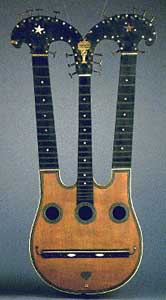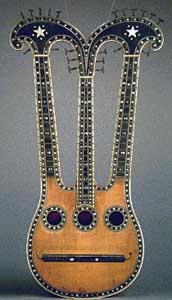|
Organology: Harp Guitar "Relatives" Note to the casual reader or researcher: This Reference Gallery features historical instruments that are not harp guitars, but “relatives” or distant “cousins” – presented on Harpguitars.net for historical and organological comparison.
Harpolyres In rare instances, there are instruments that are clearly meant to be tuned and played as harp guitars, but are provided with a full set of frets under all strings (see Fretted Harp Guitars). In some cases, the frets may be intended to serve as a series of "nuts," behind which a capo (a device which clamps the strings to the fingerboard) is attached to change the pitch of an entire harp string bank. However, while this may have been an option for the unique harpolyre, it is not the main intent. With the assistance of harp guitar player and scholar John Doan, I have finally been able to properly analyze this infamous instrument. See bottom of page for image copyright information UPDATE March, 2015: December, 2014 saw the publication of The Grove Dictionary of Musical Instruments (Second Edition), for which I had the honor of editing the "Harpo-lyre" entry, along with several others. |
| Harpolyre Patented by Jean Francois Salomon in 1829 (and built by Andre Augustin Chevrier, according to the BMFA), this is a very interesting instrument, and a difficult one to classify. Since it is fully fretted, it cannot technically qualify as a "true" harp guitar by any definition. Yet it was clearly designed to be played very much like an intricate harp guitar. Ergo, I created the new classification of "fretted harp guitars" - however, I don't want to make too much of this term, as I expect it will confuse the casual reader into thinking I consider it a type of true harp guitar. It is not. Nor is it a "triple-neck" guitar, nor a type of lyre guitar. Despite most major museums having specimens, no scholar has addressed the instrument in any detail, though many have noted the unusual tunings of the outer necks - obviously not intended for chords. Yet they are fully fretted, even extending to glued-on soundboard frets in some specimens. That is Salomon's red herring. Until now scholars have avoided analysis of the instrument, especially the use of the outer necks. The patent (which I have yet to obtain) apparently does not offer enough clues about the intention of the additional necks. If mentioned at all, most scholars have proposed that the outer neck frets are only there to allow for full, accurate chromatic pitch changing of the "harp strings" with a capo. I likewise reported this originally, as it made the most sense. However, this turns out not to be the case at all. In the ten pieces written for harpolyre by Fernando Sor, it seems that there is no use of (or need for) a capo. So why the frets? It took the combination of an actual harp guitarist (John Doan), an actual playable instrument (John's first German harpolyre copy, now fully restored by Kerry Char, pictured below, and later a bonafide harpolyre specimen) and the music (which John has patiently kept filed for thirty years until the opportunity could present itself!) - for the instrument to be properly understood. First the tuning: I previously reported the tuning of the outer necks an octave off, as this is what I was able to unearth by all previous authors. In actuality, the tuning is quite interesting. The middle 6-string neck is tuned exactly like a standard guitar. The lower neck on the left contains 7 bass "harp" strings, tuned to descend chromatically from Eb (adjacent to the neck's low E) down to A (an octave lower than the main neck's 5th string). The right neck contains, not treble strings, but 8 mid-range "harp" strings - tuned diatonically in the key of C, starting with a low C matching the third fret on the 5th string of the main neck, up to the C on the main neck's 2nd string - the pitch of middle C. Now the frets: Sor clearly marked his music where each neck was to be used with abbreviations for "Chromatic" (sub-bass strings) or "Diatonic" (harp strings). The basses are only played open, as in a standard harp guitar. It is interesting to note that the banks of strings are separated by a huge gap - making the stretch to play the basses with the thumb and the standard strings with the fingers quite difficult - even for an accomplished harp guitarist. The mid-range harp strings are also played open, for a harp-like tonal effect that is delightfully unique among all historical or contemporary harp guitars. A harp-like figure may be played while the left hand sustains its previously-played chord on the main neck. Or a difficult, multi-neck arpeggiated chord may be called for, consisting of 3 open harp strings on the third neck and 2 notes on the main neck. And then, very rarely, the frets under the last, highest string of the third neck are called into play - ascending up the scale, or used for a "pull-off" grace note into a harp figure. Except for these rare single string effects, there is absolutely no need for a full range of frets on the outer necks. The fret "overkill" is simply an aesthetic design choice, while the frets on the bass neck are their purely for decorative symmetry - as stated by Salomon himself. Thus, disregarding the rare occasional use of that one fretted harp string, we have a harp guitar much like John Doan's own contemporary creation - where three banks of strings are played simultaneously: standard, sub-bass and super-treble (in the case of the harpolyre, mid-range). Because of those frets, and my Definition technicality - I've created this new classification of stringed instrument specifically for this unique "fretted harp guitar"! Stephen Sedgwick adds: "The 'Harmonicon' of December 1829 reveals the philosophy behind the introduction of the Harpolyre. |
 |
 |
 |
 |
| Harpolyres, c.1829 | |||
|
If you enjoyed this article, or found it
useful for research, please consider making a donation to The
Harp Guitar Foundation, |
|
|
|
All Site Contents Copyright © Gregg Miner, 2004, 2005, 2006, 2007, 2008, 2009, 2010, 2011, 2012, 2013,2014. All Rights Reserved. Copyright and Fair Use of material and use of images: See Copyright and Fair Use policy. |